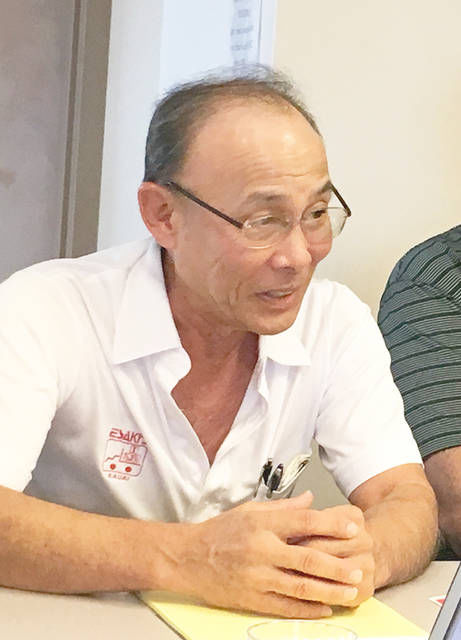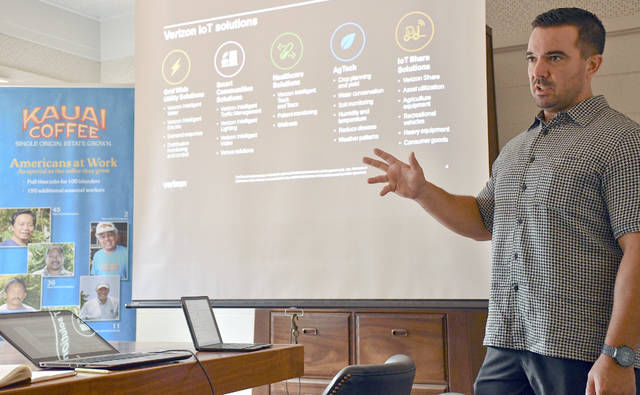LIHUE — Locally sourced ingredients are the mainstay for Greg Askew’s Kauai-based business, OnoPops. The Hawaii popsicle operation slings frozen treats in stores and at farmers’ markets across the state, and has dozens of flavors including staples like chocolate and
LIHUE — Locally sourced ingredients are the mainstay for Greg Askew’s Kauai-based business, OnoPops.
The Hawaii popsicle operation slings frozen treats in stores and at farmers’ markets across the state, and has dozens of flavors including staples like chocolate and twists like habanero and egg.
Finding the ingredients can get complicated, Askew said. So, when the Kalaheo man heardVerizon was coming to Kauai to air ideas for an islandwide agriculture network, he wanted in.
“I, as a buyer, am looking for an organized market that has the producers on the other side that are feeding into it,” Askew said. “That’s what I’m looking for.”
Askew was one of about 15 people who met Tuesday to discuss using Verizon’s new Internet of Things (IoT) technology to streamline communications and production within Kauai’s agriculture sector.
It was the beginning of the three-day Verizon Agriculture Network Workshop, hosted by Verizon, county Office of Economic Development, the community group Aina Ho’Okupu O Kilauea and Farmer’s Group.
Members of the organizations met with island growers, distributors and buyers to hear Verizon’s options for crop monitoring, sale and distribution.
Visits to Kauai Coffee Company and Kauai Shrimp Farm, Moloa‘a Organica and Grove Farm are on the table as well during the workshop as Verizon representatives learn Kauai’s agricultural needs and practices.
It’s a chance for Kauai to further integrate technology and agriculture, and an opportunity for Verizon to flex its muscles in areas other than cellular devices.
“We’re more than a cell phone company,” said Kevin Welsh, who has been focused on IoT and its uses in agriculture for Verizon.
Distribution hiccups could be solved using the IoT platform ThingSpace, which would connect buyers with growers in one islandwide database.
That would be helpful for Askew, who said if his usual grower can’t supply a product, he has to go elsewhere for ingredients.
“There is not a traditional agriculture market on this island,” Askew said. “If I need to find something, I have a spreadsheet of growers I call directly. If I can see someone else has got it and doesn’t have a buyer for it, then let’s put it together.”
Destination mix-ups are a challenge for Earl Kashiwagi, owner and operator of distributor Esaki’s Produce. Though they only happen about 1 percent of the time, each mix-up generally comes with at least a $20,000 price tag.
“It happens when errors are being made and our Matson container ends up on Maui, so we call the airlines over there and say, ‘can we get our container flown over to Kauai,’” Kashiwagi said.
Some shipping containers have sensors that can be scanned after the container’s journey, according to Wendell Kam, former manager at ocean shipper Young Brothers.
Knowing the moment a container with produce surpasses temperature restrictions would be helpful for everyone involved.
Verizon’s IoT technology could use data from M2M sensors to report real-time travel conditions of products to both growers and buyers.
“For his (Kashiwagi’s) product, it’s important because it’s out in the elements and it’s perishable,” Kam said.
And the addition of technologies like sensors and IoT could entice the younger generation back into agriculture, said Yoshito L’Hote, executive director of Aina Ho’Okupu O Kilauea.
The group stewards the Kilauea Community Ag Center, which is being developed as a place to learn and begin a farming business.
“Data-driven farming, for the youth, it’s second nature,” L’Hote said. “We need to create entrepreneurs, and our hope with Kilauea Ag Center is we provide that ground.”



